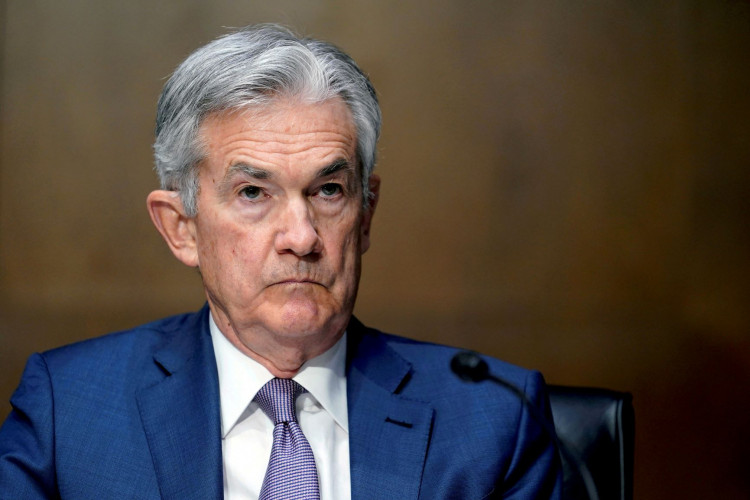In the policy meeting that concluded on Wednesday, the Federal Reserve maintained its key interest rate for the third consecutive time and hinted at a faster-than-expected decline in inflation, opening the door for rate cuts next year.
With inflation slowing and the economy stabilizing, the Federal Open Market Committee (FOMC) unanimously agreed to keep the federal funds rate in the target range of 5.25%-5.5% and continue reducing the balance sheet, allowing for a monthly reduction of $95 billion in bond holdings.
The "dot plot" released after the meeting, which outlines the rate path, indicates that committee members expect at least three rate cuts of 25 basis points each in 2024. This is less aggressive than the market's bet of five rate cuts but more so than the Fed's previous projection.
In September, Fed officials expected another rate hike by the end of the year, followed by two rate cuts next year. The last rate hike by the Fed was in July, by 25 basis points. According to the Chicago Mercantile Exchange's "FedWatch" tool, there is an 88.3% probability that the Fed will significantly ease by the end of next year, cutting rates by 125 basis points.
The "dot plot" also shows that members expect four more rate cuts in 2025, totaling a full percentage point, and three additional cuts in 2026, bringing the federal funds rate back to the 2%-2.25% range, close to the long-term rate outlook.
Fed Chair Jerome Powell emphasized in the post-meeting press conference that the dot plot predictions are not a preset plan. He stated that further rate hikes to eliminate price pressures are not ruled out, but he acknowledged that officials discussed when it would be appropriate to start cutting rates at this week's meeting.
"No one is declaring victory; it's too early," Powell said, noting that officials are now considering when they might start cutting rates as inflation slows. "It's starting to come into our view, obviously a topic the whole world is discussing, and it was a topic of discussion at our meeting today."
The post-meeting statement released by the Fed on Wednesday also underwent minor adjustments, highlighting a shift in tone. Officials noted that they would monitor a range of data and developments to see if "any" additional policy tightening is appropriate. This word did not appear in the Fed's November policy statement.
In another shift, the committee acknowledged that inflation "has eased over the past year, although it remains elevated." Additionally, most participants now believe that the risks to price growth are broadly balanced.
Market expectations suggest that the decision to hold rates steady signals the end of the current rate hike cycle. Since March 2022, the Fed has cumulatively raised rates 11 times, increasing the federal funds rate by 525 basis points to the highest level in over 22 years.
Policymakers have been careful not to rule out the possibility of rate hikes in policy statements, but with inflation declining faster than officials anticipated this year, another rate hike seems increasingly unlikely. Data released on Tuesday showed that the U.S. Consumer Price Index (CPI) rose 3.1% year-over-year in November, with core CPI increasing by 4%, both in line with expectations.
The Fed's preferred inflation measure, the Personal Consumption Expenditures (PCE) Price Index, rose 3% year-over-year in October, the smallest increase since March 2021; core PCE (excluding volatile food and energy) also fell from 3.7% in September to 3.5%.
In the latest inflation forecast, Fed officials expect core PCE inflation to rise 3.2% this quarter compared to last year, lower than the 3.7% predicted in September. They anticipate core PCE inflation to drop to 2.4% by the end of next year, lower than the 2.6% forecast in September.
Officials' unemployment rate predictions remained largely unchanged, maintaining this year's unemployment rate expectation at 3.8%, in line with September's forecast; they expect the unemployment rate to remain at 4.1% in both 2024 and 2025.
The labor market has been cooling but remains robust. The U.S. unemployment rate fell from 3.9% to 3.7% in November, with private-sector employers adding an average of 130,000 jobs per month over the past six months, down from 228,000 in the previous six months.
Meanwhile, Fed officials raised their forecast for the annualized growth rate of the U.S. Gross Domestic Product (GDP) in 2023 to 2.6%, up 0.5 percentage points from September. They expect the U.S. GDP to grow by 1.4% in 2024, down 0.1 percentage points from the previous forecast.
Many economists had believed about a year ago that Fed officials needed to raise rates to a level that would create enough slack (such as unemployed workers and idle factories) to significantly slow inflation. However, with supply chains repairing and workers entering the labor market, the U.S. economy has curbed wage and price increases without causing significant weakness.
The U.S. stock market was boosted by Fed officials' expectations of multiple rate cuts next year. The Dow Jones Industrial Average, representing the core sectors of the U.S. economy, closed at a record high, rising 1.4% to 37,090.24 points, surpassing 37,000 points for the first time. The previous closing high for the index was 36,799.65 points on January 4, 2022. Additionally, the S&P 500 Index rose 1.37% to 4,707.09 points, and the Nasdaq Composite Index, heavy with technology stocks, increased 1.38% to 14,733.96 points.






